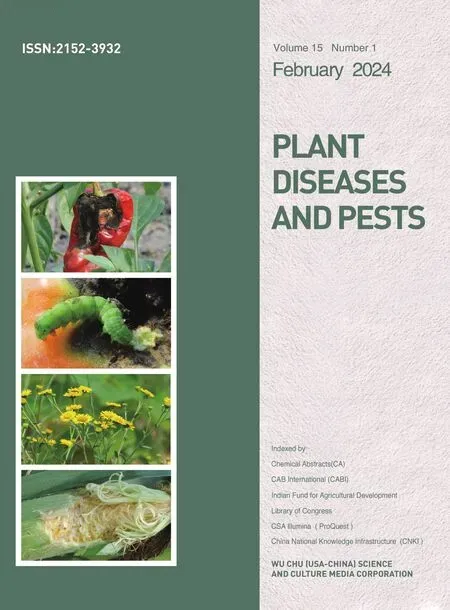Investigation and Analysis of Main Diseases of Landscape Plants in the Main Urban Area of Lu’an City
Gao LIU, Hao SONG, Juanjuan HU,3,4*
1. Forestry Harmful Organism Control and Quarantine Center of Lu’an County, Lu’an 237000, China; 2. College of Environment and Tourism, West Anhui University, Lu’an 237012, China; 3. Anhui Engineering Laboratory for Conservation and Sustainable Utilization of Traditional Chinese Medicine Resources, West Anhui University, Lu’an 237012, China; 4. Key Laboratory of Biomimetic Sensor and Detecting Technology of Anhui Province, West Anhui University, Lu’an 237012, China
Abstract To figure out the disease occurrence of landscape plants in the main urban area of Lu’an City, the author investigated the disease occurrence of landscape plants in park green space, residential green space, unit attached green space and main road in the area under administration. The survey results showed that there were 29 species of urban landscape plant diseases, mainly powdery mildew and spot diseases. According to the characteristics of the diseases, the causes and problems of the diseases were analyzed, and the corresponding prevention and control measures were put forward.
Key words Landscape plant; Disease species; Investigation; Status analysis; Lu’an City
1 Introduction
Disease is a regular issue encountered in the process of landscape plant maintenance[1]. Mild disease will affect plant growth and development, resulting in local necrosis, decay, early defoliation, dead branches and other problems. Severe disease will lead to the death of the whole plant, resulting in significant losses to the ecological value, economic value and ornamental value of landscape plants[2-3]. There are few studies on landscape plant diseases in Lu’an City. This paper mainly investigated the species, pathogens and symptoms of common landscape plant diseases in different types of landscape greenland in the main urban area of Lu’an City. On this basis, the occurrence regularity and existing problems of landscape plant diseases in the main urban area of Lu’an City were further analyzed, and then scientific and reasonable prevention and control methods were put forward, in order to provide a basis for the prevention and control of landscape plant diseases in Lu’an City and help Lu’an to create a good urban ecological environment.
2 Survey targets and methods
2.1 Survey targets and locationsThe incidence of landscape plant diseases in representative park green space, unit attached green space, road green space and residential green space in Lu’an urban area was investigated (Table 1).

Table 1 Main types and locations of green space in the main urban area of Lu’an City
2.2 Survey methodsOn the basis of mastering the current production status of urban landscape plants and the types of main landscape green space, record charts for disease survey were formulated. Diseases were surveyed regularly at fixed points according to their occurrence time. The disease species, occurrence time, occurrence regularity and site conditions were recorded in detail and photographed, and disease specimens were made when necessary. For the convenience of users, diseases were classified by symptom types.
3 Results and analysis
3.1 Disease species and hazardsAs shown in Table 2, there were 29 species of urban landscape plant diseases, and spot diseases accounted for the majority, such as anthracnose, brown spot disease, black spot disease and leaf spot disease. The diseases mainly caused by fungi, bacteria, phytoplasma, parasitic seed plants (dodder damage), and physiological causes. Fungal diseases accounted for the largest proportion, with 23 species; followed by physiological causes (2); while other pathogens caused one disease each. Leaves suffered the heaviest damage, followed by branches, and roots were less affected. The host plants of landscape plant diseases mainly wereOsmanthusfragrans,Prunuspersica,P.cerasifera,Photinia×fraseriand other often used landscape plants, and diseases mainly occurred from April to October, with moderate harms.
3.2 Cause analysis of disease
3.2.1Unreasonable collocation of landscape plants. First, disease-prone tree species are centrally collocated. In the investigation, it is found thatP.persica,P.cerasifera,P.mumeandCerasusserrulatathat are prone to diseases are planted together. OnceP.persicais infected by perforation disease, gummosis or brown rot disease, other tree species adjacent toP.persicaare more susceptible to these diseases, resulting in death of large stands in severe cases. Second, trees are planted at too high density. In the process of plant allocation, problems such as poor ventilation and uneven light exposure will occur in the stand in case of too high planting density, thus reducing the overall stand resistance and aggravating the occurrence of landscape plant diseases[3-4]. There are also some landscape plants infected by heteroecious pathogens, such asPyrusspp.,Maluspumila,Pseudocydoniasinensis,M.spectabilis,etc.When there are cypress trees growing around 2.5-5.0 km, these tree species are more susceptible to pear rust.
3.2.2Deterioration of urban ecological environment. With the acceleration of urbanization, there are excessive hardening of the ground and various environmental pollution in cities, which affect the occurrence and development of diseases to varying degrees[5]. In recent years, with the acceleration of urbanization in Lu’an City, the growing environment of some landscape plants is getting worse and worse. For example, street trees are affected by automobile exhaust and factory sewage to varying degrees, and the deterioration of soil fertility, pH and permeability leads to the decline in the growth potential of landscape plants and promotes the development of diseases[6]. In some areas, the ground around the green space is high with poor drainage. When it rains continuously, plants will be infected by anthracnose, leaf spot disease, root rot disease and other diseases[7].
3.2.3Obvious phenomenon of "focusing on planting and ignoring management" in the process of landscape construction. In the process of landscape construction, there is an obvious phenomenon of "focusing on planting and ignoring management ", and the investment in management and protection after planting is insufficient. Although disease control has been carried out in the management of some plants, the selection and use of chemicals are not targeted, which not only fails to achieve the ideal effect, but also causes resource waste and environmental pollution to a certain extent. In the daily maintenance of landscape plants, if diseases and residues are not removed in time, and effective and timely prevention and control are not carried out in the early stage of disease occurrence, it often leads to the outbreak of diseases in large areas, seriously threatening the health of landscape plants.
4 Control suggestions
4.1 Strengthening plant quarantineWith the development of urban green space planning, it is often necessary to introduce some exotic landscape plants from other places in order to enrich the landscape architecture and increase the seasonal appreciation, which provides a way for the transmission and spread of diseases. Therefore, plant quarantine system should be strictly implemented when transferring landscape seedlings and landscape plants to prevent the introduction of exotic diseases, especially dangerous diseases.
4.2 Strengthening disease monitoring and prevention guidanceFirstly, according to the occurrence time, frequency, species, damage degree and other factors of early and recent diseases of landscape plants, the regularity and characteristics of disease occurrence should be summarized. Secondly, according to the climate, soil and characteristics of landscape plants in Lu’an City, as well as effective means of disease prevention and control in other cities, the incidence of landscape plant diseases in Lu’an City should be studied comprehensively, and a set of effective means of prevention and control must be established. Finally, prevention and control measures must be adopted promptly to maintain its timeliness and novelty, so as to provide a scientific guidance for disease prevention and control.
4.3 Optimizing the collocation of landscape plantsIn the planning and design stage, the relationship between the collocation and biological characteristics of landscape plants should be concerned, and the inspection and analysis of diseases in the process of introduction and domestication should be strengthened[3]. Diversification and reasonable mixing should be emphasized in the collocation of landscape plants, which can not only improve the anti-interference, stress resistance and stability of plant communities, but also take into account the development of local characteristics, achieving the effect of "artificial as it is, the landscape must look ingenious and natural"[8]. Local tree species in Lu’an City mainly includeTriadicasebifera,Zelkovaserrata,Albiziajulibrissin,Liquidambarformosana,Camelliajaponica,etc.These tree species adapt to the climate conditions of Lu’an City, with adversity acclimation and tenacious growth even in harsh natural environment and soil conditions.
4.4 Improving the level of maintenance and management
The measures, including selecting disease-resistant landscape plant varieties, promptly loosening soil and removing weeds, cultivating the soil around the roots appropriately, strengthening the management of water and fertilizer, increasing the application of phosphorus, potash and organic fertilizer, reasonable shaping and pruning, promptly cutting off diseased and insect branches, dead branches, cross branches, weak branches to increase ventilation and light[8-9], should be adopted to reduce the source of infection of landscape plants and prevent the occurrence of disease. Relevant departments should regularly carry out professional training on plant protection for front-line landscape maintenance personnel, and popularize the consequences and prevention methods of plant diseases to the general public through the way of issuing leaflets, so that they truly realize the impact of disease problems on urban economic development, urban ecological security and urban greening effect, and make concerted efforts to participate in the protection of ecological environment.
4.5 Rational use of physical control, biological control and chemical controlA variety of measures can be adopted to control landscape plant diseases. First, seedling disinfection, soil disinfection, mechanical barrier and other methods can be taken for prevention. For example, the breeding materials carrying the virus are disinfected with high temperature, or the seeds are exposed to sunlight, or the soil is burned (with grass, wood,etc.). Second, clearing the debris, cutting off the diseased branches, eradicating the diseased plants, scraping the diseased spots, cleaning up the fallen leaves, covering the film and other physical control measures can be adopted. Third, biological agents such as abamectin, diflubenzuron, Bt emulsion, azadirachtin and nicotine+matrine are mainly used to control landscape plant diseases[10], which can not only control the diseases effectively and sustainably, but also have little environmental impact. Forth, under special circumstances, pesticides with low toxicity, high efficiency and little pollution to the natural environment can be used for prevention and control.
5 Conclusions
Landscape plant disease prevention is an indispensable part in the maintenance process of landscape plants. Disease control should be based on the overall concept of urban environment, with prevention as the primary task, so as to achieve comprehensive prevention and control. The concept of "green prevention and control" should be strengthened to give full play to the role of landscaping. It is necessary to implement effective control methods suitable for the characteristics of Lu’an City, which must coordinate with each other and use less or no chemical agents. Starting from seedling cultivation, the control work of nursery and plant inspection must be strictly checked, so as to make scientific and systematic control of landscape plant diseases. Through this survey, the occurrence of plant diseases in urban parks, residential areas, roads and other green space in the main urban area of Lu’an City has been generally understood, and the species and causes of the diseases have been mastered. Meantime, targeted prevention and control countermeasures are also put forward, in order to provide a reference for the prevention and control of landscape plant diseases in the urban area of Lu’an City.
- 植物病虫害研究(英文版)的其它文章
- Comprehensive Prevention and Control Technology of Vegetable Diseases and Pests in Shandong Province
- Technical Points of Green Prevention and Control Technology of Major Diseases and Pests in Lixian Rhubarb (Rheum palmatum L.)
- Risk Analysis of Passalora sequoiae Invasion to China with Imported Coniferous Wood
- Determination of Ten Kinds of Alpha-2 Agonists Residues in Animal Derived Food by UHPLC-Triple Quadrupole/Composite Linear Ion Trap Mass Spectrometry
- Effects of Low Temperature Stress on Germination and Physiological Characteristics of Different Sweet Maize Varieties
- Research on Blended Teaching Mode: A Case Study of Floristry

